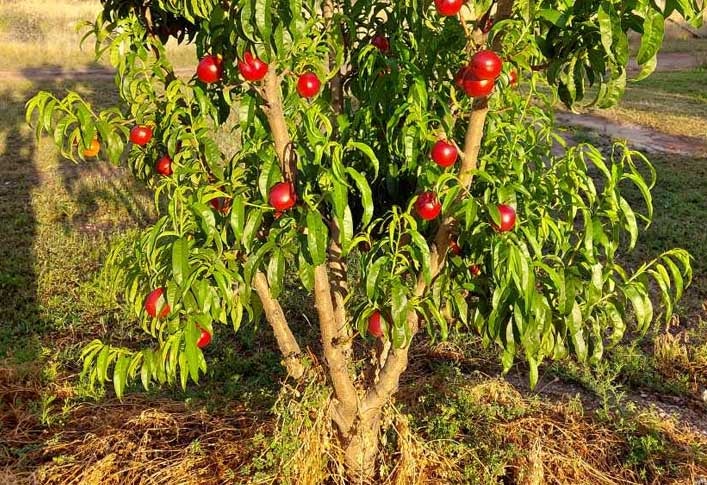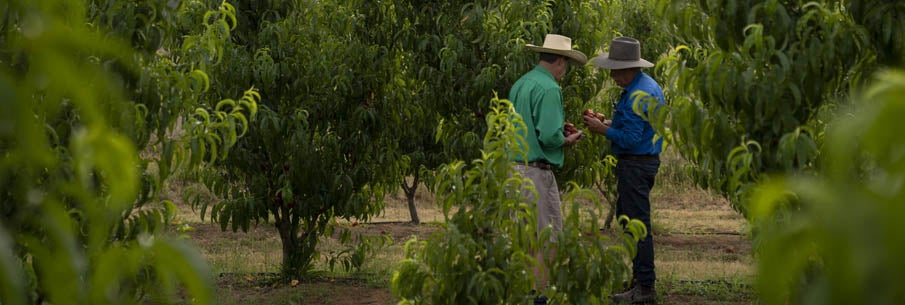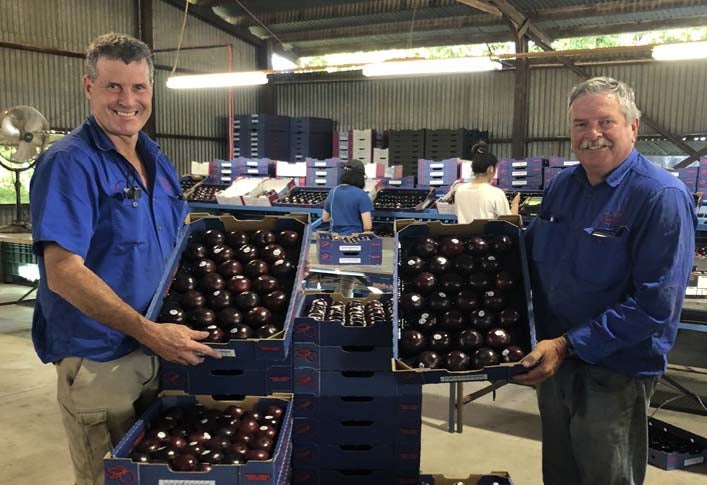Posted by on
17/06/2021
Nothing signals the start of an Australian summer better than that first bite of a plump, ripe piece of stone fruit – the initial sweet explosion inevitably cascading down your chin.
And chances are, Australia’s first taste of summer was produced on Andrew and Graham Finlay’s Stanthorpe district ‘Pikes Creek Orchard’.
The brothers and their families are in a plum position when it comes to producing some of Australia’s most flavoursome fresh produce – their climate, topography and geography proving a unique natural advantage in stone fruit production.
And when it comes to growing plums, they’ve hit the sweet spot.
At 600m above sea level, the Traprock region, 40km from Stanthorpe, enjoys optimal conditions for early season plum production.
During the cold winter, this elevation allows the trees’ hormones to naturally break down for flowering and fruit set, and August’s overnight chill perfectly complements warm day-time temperatures, enabling sugars to come in quickly for superior flavour.

It’s this unique combination that affords the brothers the rare privilege of being the first supplier of plums into the Australian market through Woolworths and Coles and amongst the first suppliers of plums to the Melbourne, Sydney and Brisbane central markets.
Andrew said their plums are available late during the first week in November – the first plums to meet supermarket product specifications so early in the season.
“We have a really nice window from November through to the middle of December when our fruit has a naturally superior sweetness and shelf-life than the rest of Australia, and as such we have been able to form relationships with Coles and Woolworths ensuring we are the first plum suppliers for the season.”
Peaches and nectarines are also included in the 15,000 tree operation, and while they too were once considered early season, varietal developments and the expansion of northern Victorian production regions has increased early season supply in the market in recent decades.
“When we started 35 years ago there were limited varieties of palatable plums before Christmas, but with improved genetics our opportunities have been enormous,” Andrew said.
Almost all of Australia’s stone fruit genetics are adopted from California and Europe, but with such a variance in soil type and temperature between those regions and here, trial and error has led local progression.

“We plant a small number of trees of new varieties for trialling most years and evaluate them before deciding to commit to a commercial sized planting – sometimes the trials work out, sometimes they don’t – but we don’t have any of the original varieties we started with, and the progression in the industry within that time has been extraordinary.”
Trees are removed at the end of their commercial lifespan – generally between 10 and 20 years – before a cover crop is planted, and the soil left to rest for 12 months before a new variety is established.
On-farm, progressive innovation has also facilitated increased efficiency and underpinned a modern, sustainable operation.
“We use integrated pest management techniques, such as natural predators and good orchard hygiene, to a successful level so we don’t have to rely only on chemicals,” Andrew said.
The growth of native clover at the tree-base over winter fixes nitrogen from the atmosphere into the soil through natural bacteria living in nodules on the roots.
The clover then collapses into valuable mulch over summer, helping to reduce the use of nitrogenous fertilizers and herbicides and helping to retain soil moisture while improving soil structure, Andrew explained.
Annual top dressings of compost and the use of natural soil conditioners also help to improve soil structure and contribute to a significant reduction in the use of conventional fertilizers, further lowering the production’s environmental footprint.
Increased water use efficiency is also a priority, with moisture monitoring probes sending real time data around soil moisture, and tree moisture needs wirelessly through an app.
The use of this technology enables quick and accurate decisions on water needs for water saving, as well as maximum production.
“This technology has really allowed us to find the sweet spot for our tree moisture needs, so trees are getting the exact amount they need to produce the best fruit.”
The balance of inputs necessary to produce optimal fruit is a fine juggling act, but technology and accurate data is helping guide the way.
“We ensure our fertiliser schedule is spot on, we taper our nitrogen content towards harvest in conjunction with increased levels of calcium to improve fruit firmness and shelf-life whilst increasing potassium for sweetness.”
Fruit is packed straight from the trees in the Finlay’s modern packing shed, from which they’ve been able to value-add by packing neighbouring orchards – and then straight to the consumer.

“When we started here in 1986, food provenance wasn’t a consumer focus – we knew how valuable the region was for producing beautiful quality stone fruit, and now we’re in this really fantastic position where consumers are so engaged in knowing where their fruit comes from, and it’s really exciting.”
“Our business goal since day one has been understated, but unwavering – if someone is spending their hard earned money on our fruit, we want them to enjoy it, and have the best experience possible.
“Growing and providing Australia with fruit that is nutritious, full of flavour, safe to eat and grown in a production system that is both ethical and sustainable is the benchmark that we have set for ourselves.”
Thanks Andrew and Graham for providing Australia with delicious, fresh summer produce – from the farm to the fruit bowl.
